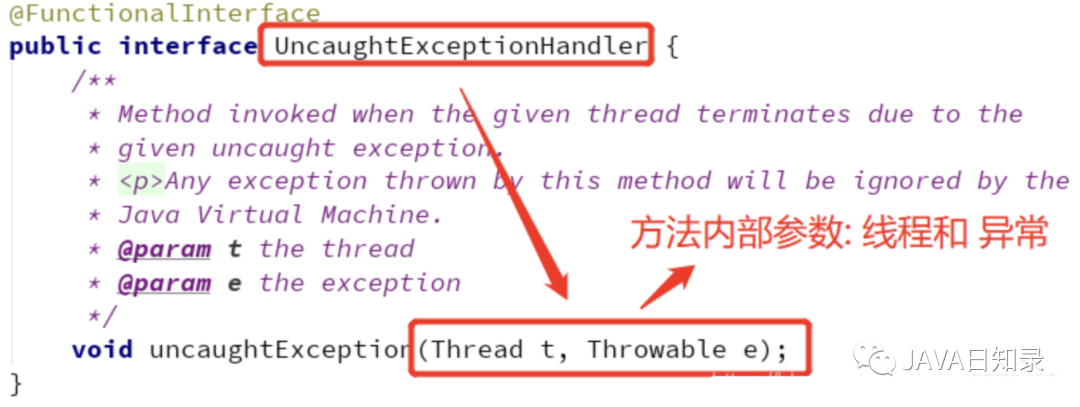面试官微微一笑:线程池中线程抛出了异常,如何处理?(送书)
在实际开发中,我们常常会用到线程池,但任务一旦提交到线程池之后,如果发生异常之后,怎么处理?怎么获取到异常信息?
在了解这个问题之前,可以先看一下线程池的源码解析,从链接中我们知道了线程池的提交方式:submit和execute的区别,接下来分别使用他们执行带有异常的任务!看结果是怎么样的!
1 . 模拟线程池抛异常
我们先用伪代码模拟一下线程池抛异常的场景:
public class ThreadPoolException {
public static void main(String[] args) {
//创建一个线程池
ExecutorService executorService= Executors.newFixedThreadPool(1);
//当线程池抛出异常后 submit无提示,其他线程继续执行
executorService.submit(new task());
//当线程池抛出异常后 execute抛出异常,其他线程继续执行新任务
executorService.execute(new task());
}
}
//任务类
class task implements Runnable{
@Override
public void run() {
System.out.println("进入了task方法!!!");
int i=1/0;
}
}运行结果:

submit的方式不打印异常信息,显然在生产中,是不可行的,因为我们无法保证线程中的任务永不异常,而如果使用submit的方式出现了异常,直接如上写法,我们将无法获取到异常信息,做出对应的判断和处理,所以下一步需要知道如何获取线程池抛出的异常!
submit()想要获取异常信息就必须使用get()方法!!
//当线程池抛出异常后 submit无提示,其他线程继续执行
Future<?> submit = executorService.submit(new task());
submit.get();submit打印异常信息如下:
2 . 如何获取和处理异常
方案一:使用 try -catch
public class ThreadPoolException {
public static void main(String[] args) {
//创建一个线程池
ExecutorService executorService = Executors.newFixedThreadPool(1);
//当线程池抛出异常后 submit无提示,其他线程继续执行
executorService.submit(new task());
//当线程池抛出异常后 execute抛出异常,其他线程继续执行新任务
executorService.execute(new task());
}
}
// 任务类
class task implements Runnable {
@Override
public void run() {
try {
System.out.println("进入了task方法!!!");
int i = 1 / 0;
} catch (Exception e) {
System.out.println("使用了try -catch 捕获异常" + e);
}
}
}打印结果:

submit 和 execute都清晰易懂的捕获到了异常,可以知道我们的任务出现了问题,而不是消失的无影无踪。
方案二:使用Thread.setDefaultUncaughtExceptionHandler方法捕获异常
方案一中,每一个任务都要加一个try-catch 实在是太麻烦了,而且代码也不好看,那么这样想的话,可以用Thread.setDefaultUncaughtExceptionHandler方法捕获异常

UncaughtExceptionHandler 是Thread类一个内部类,也是一个函数式接口。内部的uncaughtException是一个处理线程内发生的异常的方法,参数为线程对象t和异常对象e。
应用在线程池中如下所示:重写它的线程工厂方法,在线程工厂创建线程的时候,都赋予UncaughtExceptionHandler处理器对象。
public class ThreadPoolException {
public static void main(String[] args) throws InterruptedException {
//1.实现一个自己的线程池工厂
ThreadFactory factory = (Runnable r) -> {
//创建一个线程
Thread t = new Thread(r);
//给创建的线程设置UncaughtExceptionHandler对象 里面实现异常的默认逻辑
t.setDefaultUncaughtExceptionHandler((Thread thread1, Throwable e) -> {
System.out.println("线程工厂设置的exceptionHandler" + e.getMessage());
});
return t;
};
//2.创建一个自己定义的线程池,使用自己定义的线程工厂
ExecutorService executorService = new ThreadPoolExecutor(
1,
1,
0,
TimeUnit.MILLISECONDS,
new LinkedBlockingQueue(10),
factory);
// submit无提示
executorService.submit(new task());
Thread.sleep(1000);
System.out.println("==================为检验打印结果,1秒后执行execute方法");
// execute 方法被线程工厂factory 的UncaughtExceptionHandler捕捉到异常
executorService.execute(new task());
}
}
class task implements Runnable {
@Override
public void run() {
System.out.println("进入了task方法!!!");
int i = 1 / 0;
}
}打印结果如下:

execute方法被线程工厂factory中设置的 UncaughtExceptionHandler捕捉到异常,而submit方法却没有任何反应!说明UncaughtExceptionHandler在submit中并没有被调用。这是为什么呢?
在日常使用中,我们知道,execute和submit最大的区别就是execute没有返回值,submit有返回值。submit返回的是一个future ,可以通过这个future取到线程执行的结果或者异常信息。
Future<?> submit = executorService.submit(new task());
//打印异常结果
System.out.println(submit.get()); 
submit并不是丢失了异常,使用future.get()还是有异常打印的!!那为什么线程工厂factory 的UncaughtExceptionHandler没有打印异常呢?猜测是submit方法内部已经捕获了异常, 只是没有打印出来,也因为异常已经被捕获,因此jvm也就不会去调用Thread的UncaughtExceptionHandler去处理异常。
接下来,验证猜想:
首先看一下submit和execute的源码:
execute方法的源码在我上一篇博客中写的很详细,点击查看execute源码,在此就不再啰嗦了submit源码在底层还是调用的execute方法,只不过多一层Future封装,并返回了这个Future,这也解释了为什么submit会有返回值
//submit()方法
public <T> Future<T> submit(Callable<T> task) {
if (task == null) throw new NullPointerException();
//execute内部执行这个对象内部的逻辑,然后将结果或者异常 set到这个ftask里面
RunnableFuture<T> ftask = newTaskFor(task);
// 执行execute方法
execute(ftask);
//返回这个ftask
return ftask;
}可以看到submit也是调用的execute,在execute方法中,我们的任务被提交到了addWorker(command, true) ,然后为每一个任务创建一个Worker去处理这个线程,这个Worker也是一个线程,执行任务时调用的就是Worker的run方法!run方法内部又调用了runworker方法!如下所示:
public void run() {
runWorker(this);
}
final void runWorker(Worker w) {
Thread wt = Thread.currentThread();
Runnable task = w.firstTask;
w.firstTask = null;
w.unlock(); // allow interrupts
boolean completedAbruptly = true;
try {
//这里就是线程可以重用的原因,循环+条件判断,不断从队列中取任务
//还有一个问题就是非核心线程的超时删除是怎么解决的
//主要就是getTask方法()见下文③
while (task != null || (task = getTask()) != null) {
w.lock();
if ((runStateAtLeast(ctl.get(), STOP) ||
(Thread.interrupted() &&
runStateAtLeast(ctl.get(), STOP))) &&
!wt.isInterrupted())
wt.interrupt();
try {
beforeExecute(wt, task);
Throwable thrown = null;
try {
//执行线程
task.run();
//异常处理
} catch (RuntimeException x) {
thrown = x; throw x;
} catch (Error x) {
thrown = x; throw x;
} catch (Throwable x) {
thrown = x; throw new Error(x);
} finally {
//execute的方式可以重写此方法处理异常
afterExecute(task, thrown);
}
} finally {
task = null;
w.completedTasks++;
w.unlock();
}
}
//出现异常时completedAbruptly不会被修改为false
completedAbruptly = false;
} finally {
//如果如果completedAbruptly值为true,则出现异常,则添加新的Worker处理后边的线程
processWorkerExit(w, completedAbruptly);
}
}核心就在 task.run(); 这个方法里面了, 期间如果发生异常会被抛出。
- 如果用
execute提交的任务,会被封装成了一个runable任务,然后进去 再被封装成一个worker,最后在worker的run方法里面调用runWoker方法,runWoker方法里面执行任务任务,如果任务出现异常,用try-catch捕获异常往外面抛,我们在最外层使用try-catch捕获到了runWoker方法中抛出的异常。因此我们在execute中看到了我们的任务的异常信息。 - 那么为什么
submit没有异常信息呢?因为submit是将任务封装成了一个futureTask, 然后这个futureTask被封装成worker,在woker的run方法里面,最终调用的是futureTask的run方法, 猜测里面是直接吞掉了异常,并没有抛出异常,因此在worker的runWorker方法里面无法捕获到异常。
下面来看一下futureTask的run方法,果不其然,在try-catch中吞掉了异常,将异常放到了 setException(ex);里面
public void run() {
if (state != NEW ||
!UNSAFE.compareAndSwapObject(this, runnerOffset,
null, Thread.currentThread()))
return;
try {
Callable<V> c = callable;
if (c != null && state == NEW) {
V result;
boolean ran;
try {
result = c.call();
ran = true;
} catch (Throwable ex) {
result = null;
ran = false;
//在此方法中设置了异常信息
setException(ex);
}
if (ran)
set(result);
}
//省略下文
。。。。。。setException(ex)方法如下:将异常对象赋予outcome
protected void setException(Throwable t) {
if (UNSAFE.compareAndSwapInt(this, stateOffset, NEW, COMPLETING)) {
//将异常对象赋予outcome,记住这个outcome,
outcome = t;
UNSAFE.putOrderedInt(this, stateOffset, EXCEPTIONAL); // final state
finishCompletion();
}
}将异常对象赋予outcome有什么用呢?这个outcome是什么呢?当我们使用submit返回Future对象,并使用Future.get()时, 会调用内部的report方法!
public V get() throws InterruptedException, ExecutionException {
int s = state;
if (s <= COMPLETING)
s = awaitDone(false, 0L);
//注意这个方法
return report(s);
}reoport里面实际上返回的是outcome ,刚好之前的异常就set到了这个outcome里面
private V report(int s) throws ExecutionException {
//设置`outcome`
Object x = outcome;
if (s == NORMAL)
//返回`outcome`
return (V)x;
if (s >= CANCELLED)
throw new CancellationException();
throw new ExecutionException((Throwable)x);
}因此,在用submit提交的时候,runable对象被封装成了future ,future 里面的 run方法在处理异常时, try-catch了所有的异常,通过setException(ex);方法设置到了变量outcome里面, 可以通过future.get获取到outcome。
所以在submit提交的时候,里面发生了异常, 是不会有任何抛出信息的。而通过future.get()可以获取到submit抛出的异常!在submit里面,除了从返回结果里面取到异常之外, 没有其他方法。因此,在不需要返回结果的情况下,最好用execute ,这样就算没有写try-catch,疏漏了异常捕捉,也不至于丢掉异常信息。
方案三:重写afterExecute进行异常处理
通过上述源码分析,在excute的方法里面,可以通过重写afterExecute进行异常处理,但是注意!这个也只适用于excute提交(submit的方式比较麻烦,下面说),因为submit的task.run里面把异常吞了,根本不会跑出来异常,因此也不会有异常进入到afterExecute里面。
在runWorker里面,调用task.run之后,会调用线程池的 afterExecute(task, thrown) 方法
final void runWorker(Worker w) {
//当前线程
Thread wt = Thread.currentThread();
//我们的提交的任务
Runnable task = w.firstTask;
w.firstTask = null;
w.unlock(); // allow interrupts
boolean completedAbruptly = true;
try {
while (task != null || (task = getTask()) != null) {
w.lock();
if ((runStateAtLeast(ctl.get(), STOP) ||
(Thread.interrupted() &&
runStateAtLeast(ctl.get(), STOP))) &&
!wt.isInterrupted())
wt.interrupt();
try {
beforeExecute(wt, task);
Throwable thrown = null;
try {
//直接就调用了task的run方法
task.run(); //如果是futuretask的run,里面是吞掉了异常,不会有异常抛出,
// 因此Throwable thrown = null; 也不会进入到catch里面
} catch (RuntimeException x) {
thrown = x; throw x;
} catch (Error x) {
thrown = x; throw x;
} catch (Throwable x) {
thrown = x; throw new Error(x);
} finally {
//调用线程池的afterExecute方法 传入了task和异常
afterExecute(task, thrown);
}
} finally {
task = null;
w.completedTasks++;
w.unlock();
}
}
completedAbruptly = false;
} finally {
processWorkerExit(w, completedAbruptly);
}
}重写afterExecute处理execute提交的异常
public class ThreadPoolException3 {
public static void main(String[] args) throws InterruptedException, ExecutionException {
//1.创建一个自己定义的线程池
ExecutorService executorService = new ThreadPoolExecutor(
2,
3,
0,
TimeUnit.MILLISECONDS,
new LinkedBlockingQueue(10)
) {
//重写afterExecute方法
@Override
protected void afterExecute(Runnable r, Throwable t) {
System.out.println("afterExecute里面获取到异常信息,处理异常" + t.getMessage());
}
};
//当线程池抛出异常后 execute
executorService.execute(new task());
}
}
class task3 implements Runnable {
@Override
public void run() {
System.out.println("进入了task方法!!!");
int i = 1 / 0;
}
}执行结果:我们可以在afterExecute方法内部对异常进行处理

afterExecute处理submit提交的异常, 要额外处理。判断Throwable是否是FutureTask,如果是代表是submit提交的异常,代码如下:
public class ThreadPoolException3 {
public static void main(String[] args) throws InterruptedException, ExecutionException {
//1.创建一个自己定义的线程池
ExecutorService executorService = new ThreadPoolExecutor(
2,
3,
0,
TimeUnit.MILLISECONDS,
new LinkedBlockingQueue(10)
) {
//重写afterExecute方法
@Override
protected void afterExecute(Runnable r, Throwable t) {
//这个是excute提交的时候
if (t != null) {
System.out.println("afterExecute里面获取到excute提交的异常信息,处理异常" + t.getMessage());
}
//如果r的实际类型是FutureTask 那么是submit提交的,所以可以在里面get到异常
if (r instanceof FutureTask) {
try {
Future<?> future = (Future<?>) r;
//get获取异常
future.get();
} catch (Exception e) {
System.out.println("afterExecute里面获取到submit提交的异常信息,处理异常" + e);
}
}
}
};
//当线程池抛出异常后 execute
executorService.execute(new task());
//当线程池抛出异常后 submit
executorService.submit(new task());
}
}
class task3 implements Runnable {
@Override
public void run() {
System.out.println("进入了task方法!!!");
int i = 1 / 0;
}
}
处理结果如下:

afterExecute这种方式,既可以处理execute抛出的异常,也可以处理submit抛出的异常

